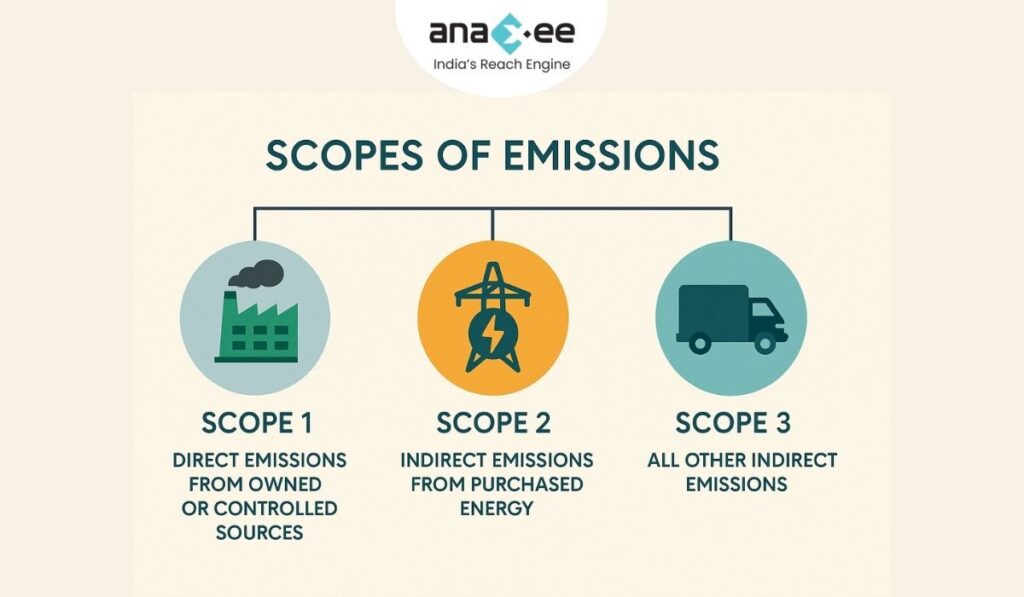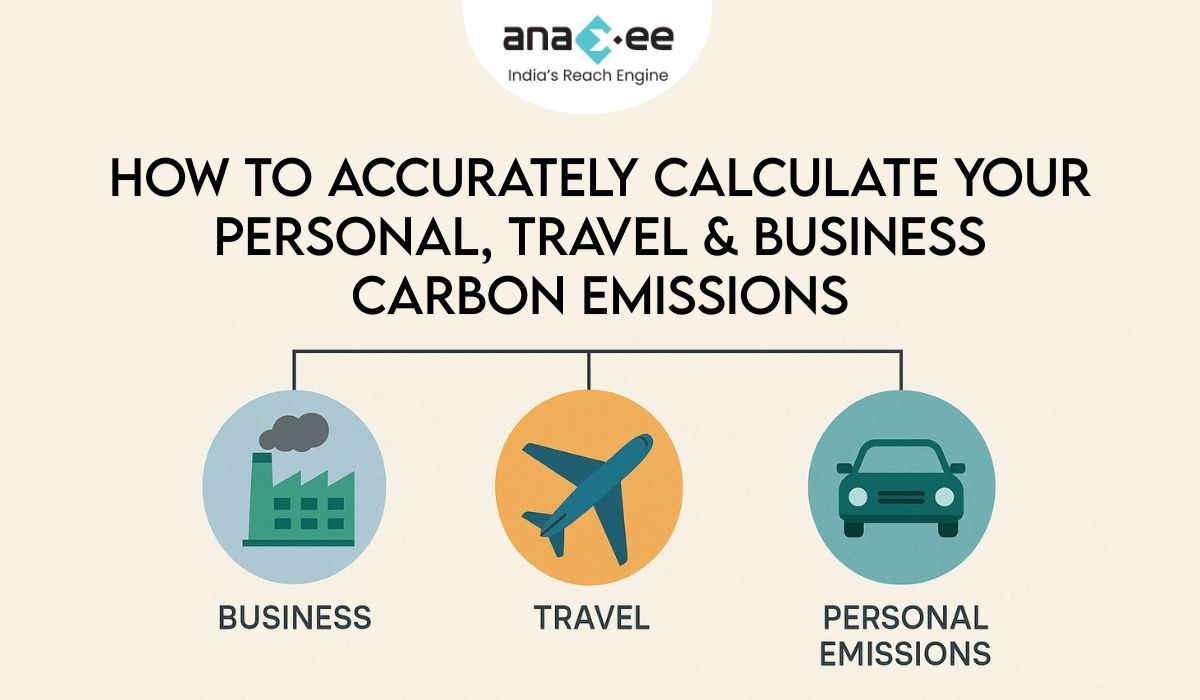1. Introduction:
Imagine you’re planning a sales trip across three cities—or booking a vacation—and you pause to ask: What’s the carbon cost of this journey? For most individuals and even businesses, that question doesn’t get asked, let alone answered with data. That’s where this blog steps in—no jargon, no abstract theory. Just clear, actionable steps to measure your emissions and understand your levers for change.
You’ll walk away knowing:
-The difference between Scope 1, 2, and 3 emissions.
-How to calculate your personal carbon footprint from daily life and travel.
-How businesses measure travel-related emissions—and streamline data challenges.
-The best tools available, and where they fall short.
-How to critically assess results and plot meaningful reductions.
Let’s start with the basics.

2. Understanding the Scopes of Emissions
-Scope 1 (Direct): Emissions you directly produce—driving your car or heating your home.
-Scope 2 (Indirect Energy): Emissions from energy you purchase—e.g. your home’s electricity or office power.
-Scope 3 (Other Indirect): Everything else you’re responsible for but don’t have control over—like business travel, flights you didn’t book directly, or rented vehicles.
This breakdown isn’t just bureaucratic: Scope 3 often dwarfs the others, especially for businesses reliant on travel. Too many individuals and companies ignore it. But airline trips, hotel stays, and third-party logistics are major carbon contributors—and in business, often the low-hanging fruit for real impact.
3. Calculating Personal Emissions
Home, Energy & Lifestyle
Use calculators like:
-EPA Carbon Footprint Calculator (home energy, transport, waste)
-UN Carbon Footprint Calculator (household, transport, lifestyle)
-Nature.org Calculator (simple and behavior-driven)
These tools categorize your inputs—electricity use, waste generation, daily travel—and give you a CO₂e estimate.
Travel & Commute
Prefer walking or cycling where possible. A European study found cyclists emitted 84% less per daily trip than motorists—and switching one car trip per day reduces your annual mobility emissions by about 0.5 tonnes.
Public transport generally emits less CO₂ per passenger than driving—especially if the mode is electric or high-capacity.
Flights
-ICAO Carbon Emissions Calculator is quick and official for airfare
-Atmosfair goes deeper—factoring in non-CO₂ effects like contrails and plane type. Their multipliers can mean 3–5× more warming impact than CO₂ alone.
Note: Carbon calculators vary. For instance, Travalyst’s TIM model once underestimated emissions—but has since revised estimates to account for non-CO₂ effects. Be cautious: every model makes assumptions.
4. Calculating Business Travel Emissions
Your simplest path: fuel-based, distance-based, or spend-based calculations.
-Fuel-based: Total fuel used × emission factor (CO₂ per liter).
-Distance-based: Kilometers traveled × per‑km emission factor. Collect mode- and region-specific data (air, rail, taxi, etc.)
-Spend-based: Use economic-based proxies when data is missing—e.g., expense × average emission per dollar.
For Scope 3, Category 6 (business travel), GHG Protocol offers structured guidance. Practical steps? Follow this:
Collect data from booking tools or expense platforms: mode, distance, class, hotel nights.
Categorise by transport mode & hotel type.
Apply emission factors from sources like DEFRA, ICAO, or Green Stay.
Translate to CO₂e, including methane and N₂O.
Aggregate by department/location for reporting
Also, tools like Deloitte’s Travel Emissions Calculator can provide quick forecasts suited for projects or events.
5. Tools & Resources at a Glance
| Use Case | Tool/Resource | Notes |
| Personal Footprint | EPA Calculator | Free, focuses on home, transport, waste |
| UN Carbon Calculator | Covers lifestyle broadly | |
| Nature.org Calculator | Easy-integration, user-friendly | |
| Travel-Specific | Sustainable Travel Calculator | Includes flights, hotels, ground transport |
| Atmosfair | Includes non-CO₂ climate effects | |
| Business Travel | GHG Protocol Scope 3 Category 6 | Authoritative, methodological |
| Deloitte Travel Tool | Ideal for forecasting | |
| Corporate Emissions | EPA Simplified GHG Calculator | Free Excel tool for small organizations |
6. Reducing Emissions & Best Practices
-Travel Smart: Walk, cycle, or use public transport where feasible. Walk and cycle reduce emissions drastically—cycling interactions result in 84% lower daily emissions.
-Flight Efficiency: Prefer direct, economy flights. Offset responsibly (Gold Standard, Cool Effect, etc.)
-Corporate Practices: Use video calls instead of flying, optimize itineraries, prioritize eco-certified hotels, and source renewable energy.
-Lifestyle Impact: Reduce consumption. A Time study of four families found that purchasing behavior (online orders, food) drove most emissions, not just travel—choices like vegetarian diets and renewable energy lowered footprints.
-Advocacy Counts: Small changes matter. Cutting meat, supporting policy shifts, resource-conscious buying—all add up.
7. A Critical Perspective
Don’t accept numbers uncritically. Tools often approximate:
-Contrail effects are frequently ignored.
-Regional energy mixes (coal vs renewables) skew averages.
-Occupancy rates (e.g., how full a flight is) change per-passenger emissions.
-Models like Google’s carbon estimates have been disputed by airlines and agricultural sectors for inconsistency.
Bottom line: Use the most granular data you can, understand assumptions, and track changes over time—not absolutes.
8. Quick 5-Step Guides
For Individuals:
Gather utility bills, commute distances, flight details.
Use a personal calculator (EPA, UN, etc.).
Identify top emission sources.
Reduce (walk more, eat plant-based, cut waste).
Offset if needed.
For Businesses:
Pull travel data and categorize.
Choose a calculation method (distance or spend-based).
Use emission factors or reliable calculators.
Aggregate by trip type or region.
Set science-based reduction goals and report transparently.
9. Conclusion & Call to Action
Measuring your emissions isn’t busywork—it’s foundational to future-focused decision-making. Knowing your footprint, even imperfectly, allows you to act so you don’t look back with regret. Start with one calculator today. Share your insights. Challenge assumptions. Pinpoint where your greatest gains lie.
At Anaxee, we believe that accountability drives innovation—not corporate greenwashing. If you want to dig deeper, consider our sustainability audit services or monthly digest on emerging tools and metrics. The future favors those who measure up—literally.
About Anaxee:
Anaxee drives large-scale, country-wide Climate and Carbon Credit projects across India. We specialize in Nature-Based Solutions (NbS) and community-driven initiatives, providing the technology and on-ground network needed to execute, monitor, and ensure transparency in projects like agroforestry, regenerative agriculture, improved cookstoves, solar devices, water filters and more. Our systems are designed to maintain integrity and verifiable impact in carbon methodologies.
Beyond climate, Anaxee is India’s Reach Engine- building the nation’s largest last-mile outreach network of 100,000 Digital Runners (shared, tech-enabled field force). We help corporates, agri-focused companies, and social organizations scale to rural and semi-urban India by executing projects in 26 states, 540+ districts, and 11,000+ pin codes, ensuring both scale and 100% transparency in last-mile operations.



